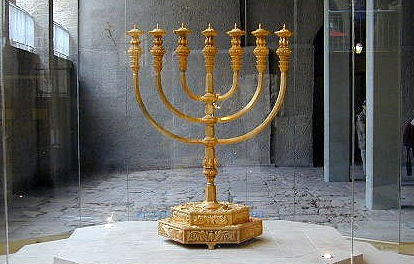It must have been a grueling task, but in the end it must have been magnificent to see. So many freely-given gifts of beautiful things – purple, crimson and blue yarns, gold and silver and bronze, beautiful stones, acacia wood, fine linens, dolphin skins.
For many years I thought of Terumah, the Torah portion that details what is needed to build the Mishkan (Tabernacle) as a philanthropy lesson. It begins with God asking the Children of Israel to bring gifts “from every person whose heart so moves them.” (Exodus 25:2) As a professional fundraiser, I loved the idea that we are asked to give whatever our heart moves us to give.
And then for a time I thought of the project as a way of keeping the people engaged. God knew that they needed to come together communally. By assigning them the enormous and meaningful task of building a sanctuary, God could teach the former slaves to transform themselves into a community with a common purpose.
Both of those are good explanations. But this week I read another, in a commentary by an artist named Caroline Rothstein. She envisions the Israelites in the desert: “There they are – a disparate band of former slaves – beginning to reckon with their identities, their purposes, their selfhoods, their truths. Both individually and collectively. Who are they? What are they doing? How shall they live? And then God assigns them an art project.”
An art project. It’s a perfect depiction of the enterprise they would embark on. An art project that engaged all of their skills as weavers, woodworkers, jewelry makers, and more. An art project that they could all contribute to, participate in. An art project that would be the home of the Divine Being.
There was just one problem. God’s instructions were complicated. An especially difficult part was making the menorah, the lamp for the entryway. It was to be made of pure gold, one piece of hammered gold. Its seven cups for holding oil were to be shaped like almond blossoms. The passage ends with a warning: “Note well, and follow the patterns that are being shown you on the mountain.” (Ex. 25:39)
I’m no artist, and the long, detailed description in the Torah makes no sense to me. An 8th century text called Midrash Tanchuma imagines Moses being as confused as I am. So he consulted with God. Here’s the imagined conversation [click here for the full text]:
“How shall we make it?” Moses asked.
“Of beaten work shall the menorah be made,” replied God.
Nevertheless, Moses still found difficulty with it, and he forgot its construction.
He went up and said, “Master of the Universe, I have forgotten how to make it!”
God said to him, “Look and make it.” He made its form out of fire and showed him its construction, Still Moses found it difficult.
So the Holy One, blessed be He, said to him: “Go to Bezalel and he will make it.”
He went down and told Bezalel, who immediately did it.
The midrash teaches a lesson that I find deeply moving. Each of us has different skills and abilities. Moses, the man of words, could not imagine the design, even when it was shown to him. Bezalel, the artist, knew exactly how to make the lamp.
This Torah portion, which begins with an invitation for each person to give from their heart, shows us that everyone matters, that everyone has a role to play in creating the world we wish to live in. We humans are made in the image of God; an image that is as multi-faceted as there are expressions of it on earth. In other words, us.
May we be blessed to each bring our unique skills, as together we do the sacred task of tikkun olam, repairing the world.

Someone’s imagination of what the original menorah looked like.

Shabbat shalom, R. Jennifer! Fabulous. Forwarded this to lay leader for today’s service and he loved it, copied it for all comers, and we had a great discussion following a group reading of it. Yasher koach! -Judith
LikeLike
Fantastic! Thanks for letting me know.
LikeLike